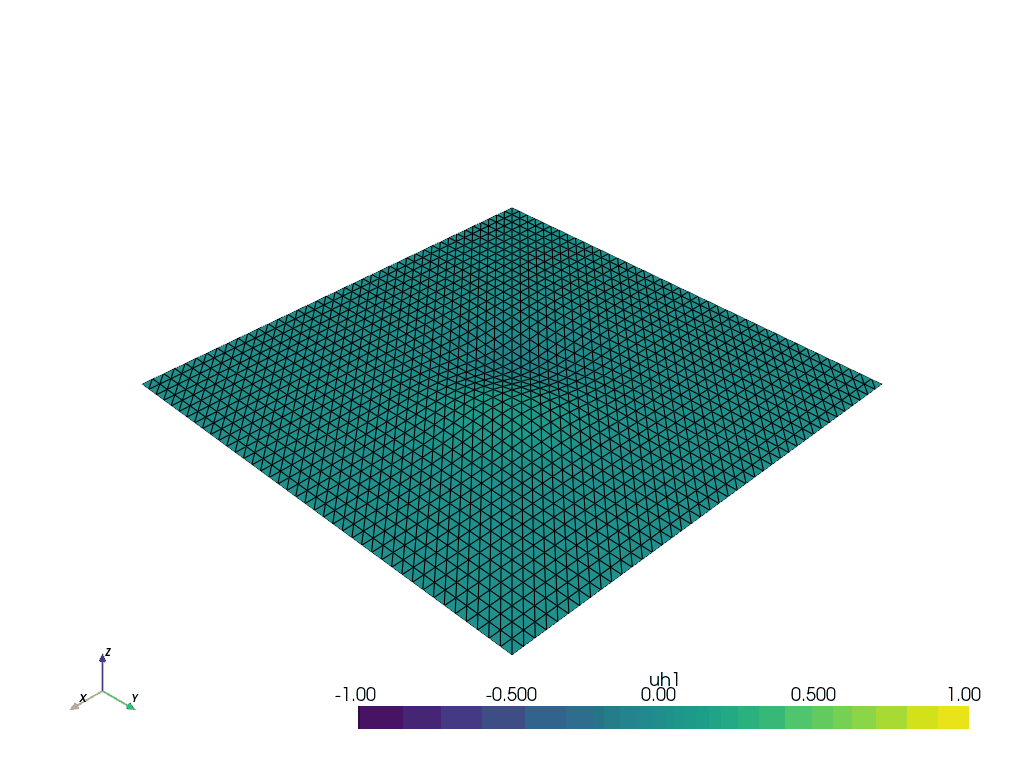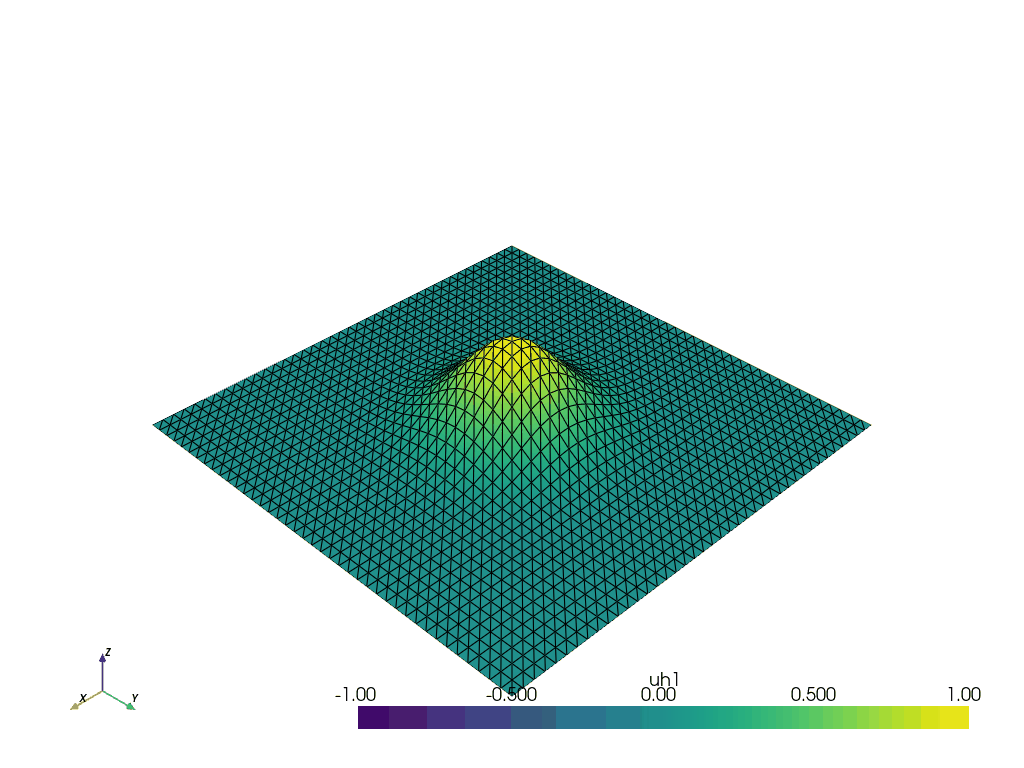Anisotropic wave system with periodic boundary conditions#
Author Jørgen S. Dokken and Markus Renoldner
License MIT
This demo illustrates how to use the MPC package to enforce periodic boundary conditions for a linear wave problem.
Mathematical formulation#
We want to compute two time-dependent functions \((u,\phi)\) on the unitsquare \(\Omega=(0,1)^2\), that solve
where the given vectorfield satisfies \((\operatorname{div} b = 0)\), that dictates the advection direction, and \((f,g)\) are given functions.
Smooth solutions of the above system also satisfy a decoupled version of the above system,
This last problem resembles the linear wave equation, which explains the wavey dynamics of the solution.
The aim of this tutorial is to show how to use periodic boundary conditions. We will choose the following setting:
where we set \((\partial\Omega = \Gamma_D\cup \Gamma_l \cup \Gamma_r)\), with
We start by the various modules required for this demo
import typing
from mpi4py import MPI
from petsc4py import PETSc
import dolfinx.fem as fem
import dolfinx.la.petsc
import numpy as np
import pyvista
from basix.ufl import element
from dolfinx import default_scalar_type, plot
from dolfinx.fem import Constant, Function, assemble_scalar, form, functionspace
from dolfinx.mesh import create_unit_square, locate_entities_boundary
from ufl import (
FacetNormal,
MixedFunctionSpace,
SpatialCoordinate,
TestFunctions,
TrialFunctions,
dx,
extract_blocks,
grad,
inner,
)
from dolfinx_mpc import (
MultiPointConstraint,
apply_lifting,
assemble_matrix_nest,
assemble_vector_nest,
create_matrix_nest,
create_vector_nest,
)
Next, we create some convenience functions to create a gif from a given function
def create_gif(
plotfunc: dolfinx.fem.Function, filename: str, fps: float
) -> tuple[pyvista.UnstructuredGrid, pyvista.Plotter]:
"""
Create a GIF animation from a given plotting function and function space.
Args:
plotfunc: The plotting function that generates the data to be visualized.
filename: The name of the output GIF file.
fps: Frames per second for the GIF animation.
Returns:
tuple: A tuple containing the grid and plotter used for creating the GIF.
Example:
.. code-block:: python
grid, plotter = create_gif(plotfunc, "output.gif", 10)
for i in range(N):
plotter = update_gif(...)
finalize_gif(...)
"""
grid = pyvista.UnstructuredGrid(*plot.vtk_mesh(plotfunc.function_space))
plotter = pyvista.Plotter(off_screen=True)
plotter.open_gif(filename, fps=fps)
plotter.show_axes() # type: ignore[call-arg]
grid.point_data["uh1"] = plotfunc.x.array
return grid, plotter
def update_gif(
grid: pyvista.UnstructuredGrid,
plotter: pyvista.Plotter,
plotfunc: dolfinx.fem.Function,
warp_gif: bool,
clip_gif: bool,
clip_normal: typing.Literal["x", "y", "z", "-x", "-y", "-z"] = "y",
):
"""
Update the plotter with the given grid and plot function, and optionally warp or clip the grid.
Args:
grid: The grid to be plotted.
plotter: The plotter instance used for plotting.
plotfunc: An object containing the data to be plotted, with an attribute `x.array`.
warp_gif: If True, warp the grid by the scalar values.
clip_gif: If True, clip the grid along the specified normal.
clip_normal: The normal direction for clipping. Default is "y".
Returns:
pyvista.Plotter: The updated plotter instance.
"""
maxval = max(plotfunc.x.array)
maxval = 1
grid.point_data["uh"] = plotfunc.x.array
if warp_gif and clip_gif:
PETSc.Sys.Print("warp and clip not possible at the same time") # type: ignore
plotter.clear()
plotter.add_mesh(grid, clim=[-maxval, maxval], show_edges=True)
elif warp_gif:
grid_warped = grid.warp_by_scalar("uh", factor=0.2 * 1 / maxval)
plotter.clear()
plotter.add_mesh(grid_warped, clim=[-maxval, maxval], show_edges=True)
elif clip_gif:
grad_clipped = grid.clip(clip_normal, invert=True)
plotter.clear()
plotter.add_mesh(grad_clipped, clim=[-maxval, maxval], show_edges=True)
plotter.add_mesh(grid, style="wireframe", clim=[-maxval, maxval], show_edges=True)
else:
plotter.clear()
plotter.add_mesh(grid, clim=[-maxval, maxval], show_edges=True)
plotter.write_frame()
plotter.show_axes() # type: ignore[call-arg]
return plotter
def finalize_gif(plotter: pyvista.Plotter):
plotter.close()
The goal is to solve the wave system using Lagrange Finite Elements. For this we propose the following weak formulation:
Here \((X^r)\) denotes the Lagrange order \((r)\), global FEM space of piecewise polynomial functions that are globally continuous, defined as
The notation \((X^r_0)\) denotes the restriction of the above space to a space with zero boundary values.
For the derivative in time, we use the Crank-Nicolson scheme. We define some matrices:
The scheme is then:
It turns out the continuous problem, as well as the fully discrete version is stable, and one can show, that solutions \((u,\phi)\) conserve the energy
We will now implement this problem in fenicsx.
dt = 0.02 # time step
t = 0.0 # initial time
T_end = 1 # final time
num_steps = int(T_end / dt) # number of time steps
Nx = 40 # number of elements in x and y direction
h = 1 / Nx # mesh size
bconst = 1.0 # magnitude of the advection field
if MPI.COMM_WORLD.size == 1:
filename_gifV = "testV.gif"
filename_gifp = "testp.gif"
else:
filename_gifV = f"testV_{MPI.COMM_WORLD.rank}.gif"
filename_gifp = f"testp_{MPI.COMM_WORLD.rank}.gif"
warp_gif = True
Mesh, spaces, functions#
We create a ufl.MixedFunctionSpace for the functions V,p
msh = create_unit_square(MPI.COMM_WORLD, Nx, Nx)
P1 = element("Lagrange", "triangle", 1)
XV = functionspace(msh, P1)
Xp = functionspace(msh, P1)
Z = MixedFunctionSpace(XV, Xp)
eps = 0.8
bfield = Constant(msh, (eps, np.sqrt(1 - eps**2)))
x = SpatialCoordinate(msh)
n = FacetNormal(msh)
Dirichlet BC Along the top and bottom wall, we set `p=0``
facets = locate_entities_boundary(
msh, dim=1, marker=lambda x: np.logical_or.reduce((np.isclose(x[1], 1.0), np.isclose(x[1], 0.0)))
)
dofs = fem.locate_dofs_topological(V=Xp, entity_dim=1, entities=facets)
bcs = [fem.dirichletbc(np.array(0.0), dofs=dofs, V=Xp)]
Periodic BC#
Along the left and right wall, we set periodic boundary conditions
tol = 250 * np.finfo(default_scalar_type).resolution
We will now identify the set \(\{(x,y) \in \partial \Omega: x=1\}\)
def periodic_boundary(x):
return np.isclose(x[0], 1, atol=tol)
Now we define the periodic identification of points on the left and right wall This identification is only valid on the periodic boundary
def periodic_relation(x):
out_x = np.zeros_like(x)
out_x[0] = 0 # map x=1 to x=0
out_x[1] = x[1] # keep y-coord as is
return out_x
For each of the sapces Xp, XV, we create a dolfinx_mpc.MultiPointConstraint
and use create_periodic_constraint_geometrical
to create the periodic constraints
mpc_p = MultiPointConstraint(Xp)
mpc_p.create_periodic_constraint_geometrical(Xp, periodic_boundary, periodic_relation, bcs)
mpc_p.finalize()
mpc_V = MultiPointConstraint(XV)
mpc_V.create_periodic_constraint_geometrical(XV, periodic_boundary, periodic_relation, bcs)
mpc_V.finalize()
We can now define the dolfinx.fem.Function for the new time step values,
as well as the trial and test functions
Note
Note that we use the mpc.function_space
as input for the functions.
# new time step values
V_new = fem.Function(mpc_V.function_space)
p_new = fem.Function(mpc_p.function_space)
V, p = TrialFunctions(Z)
W, q = TestFunctions(Z)
# initial conditions
V_old = Function(mpc_V.function_space)
p_old = Function(mpc_p.function_space)
V_old.interpolate(lambda x: 0.0 * x[0])
p_old.interpolate(lambda x: np.exp(-1 * (((x[0] - 0.5) / 0.15) ** 2 + ((x[1] - 0.5) / 0.15) ** 2)))
We set up the gifs using the convenience function defined above
2025-10-28 14:19:01.979 ( 1.098s) [ 7F8FFA3A7080]vtkXOpenGLRenderWindow.:1458 WARN| bad X server connection. DISPLAY=
We define the weak form of the left hand side and use extract_blocks
to extract the block structure of the bilinear form.
As the system matrix is time-independent, we use create_matrix_nest
to create the system matrix, and assemble_matrix_nest
to assemble the matrix once, outside the temporal loop.
A = create_matrix_nest(a_blocked, [mpc_V, mpc_p])
assemble_matrix_nest(A, a_blocked, [mpc_V, mpc_p], bcs)
A.assemble()
We define the Krylov subspace solver using petsc4py.PETSc.KSP
and use a direct LU solver as preconditioner.
As we did for the bilinear form, we define the linear form, extract the block structure, and create the
petsc4py.PETSc.Vec that we will assemble into at each time step.
We perform the time dependent solve in a temporal loop.
Note that we use assemble_vector_nest,
apply_lifting, and
backsubstitution
to handle the periodic conditions.
progress_0 = 0
for i in range(num_steps):
t += dt
# update RHS
assemble_vector_nest(b, L_blocked, [mpc_V, mpc_p])
# Dirichlet BC values in RHS
apply_lifting(b, a_blocked, bcs, [mpc_V, mpc_p])
dolfinx.la.petsc._ghost_update(
b,
insert_mode=PETSc.InsertMode.ADD_VALUES, # type: ignore
scatter_mode=PETSc.ScatterMode.REVERSE, # type: ignore
)
bcs0 = fem.bcs_by_block(fem.extract_function_spaces(L_blocked), bcs)
fem.petsc.set_bc(b, bcs0)
# solve
Vp_vec = b.copy()
solver.solve(b, Vp_vec)
dolfinx.la.petsc._ghost_update(
Vp_vec,
insert_mode=PETSc.InsertMode.INSERT, # type: ignore
scatter_mode=PETSc.ScatterMode.FORWARD, # type: ignore
) # type: ignore
dolfinx.fem.petsc.assign(Vp_vec, [V_new, p_new])
# update MPC slave dofs
mpc_V.backsubstitution(V_new)
mpc_p.backsubstitution(p_new)
# progress
progress = int(((i + 1) / num_steps) * 100)
if progress >= progress_0 + 20:
progress_0 = progress
E_local = assemble_scalar(form(inner(V_new, V_new) * dx + inner(p_new, p_new) * dx))
E = msh.comm.allreduce(E_local, op=MPI.SUM)
PETSc.Sys.Print(f"|--progress: {progress}% \t time: {t:6.5f} \t {E=:.15e}:") # type: ignore
# Update solution at previous time step
V_old.x.array[:] = V_new.x.array
p_old.x.array[:] = p_new.x.array
# gif
plotterV = update_gif(gridV, plotterV, V_old, warp_gif, clip_gif=False)
plotterp = update_gif(gridp, plotterp, p_old, warp_gif, clip_gif=False)
solver.destroy()
b.destroy()
Vp_vec.destroy()
|--progress: 20% time: 0.20000 E=3.501905082164685e-02:
|--progress: 40% time: 0.40000 E=3.501905082164701e-02:
|--progress: 60% time: 0.60000 E=3.501905082164713e-02:
|--progress: 80% time: 0.80000 E=3.501905082164706e-02:
|--progress: 100% time: 1.00000 E=3.501905082164716e-02:
<petsc4py.PETSc.Vec at 0x7f8f80e63600>
We store the GIF to file
finalize_gif(plotterV)
finalize_gif(plotterp)
PETSc.Sys.Print(f"gifs saved as {filename_gifV}, {filename_gifp}") # type: ignore
gifs saved as testV.gif, testp.gif

